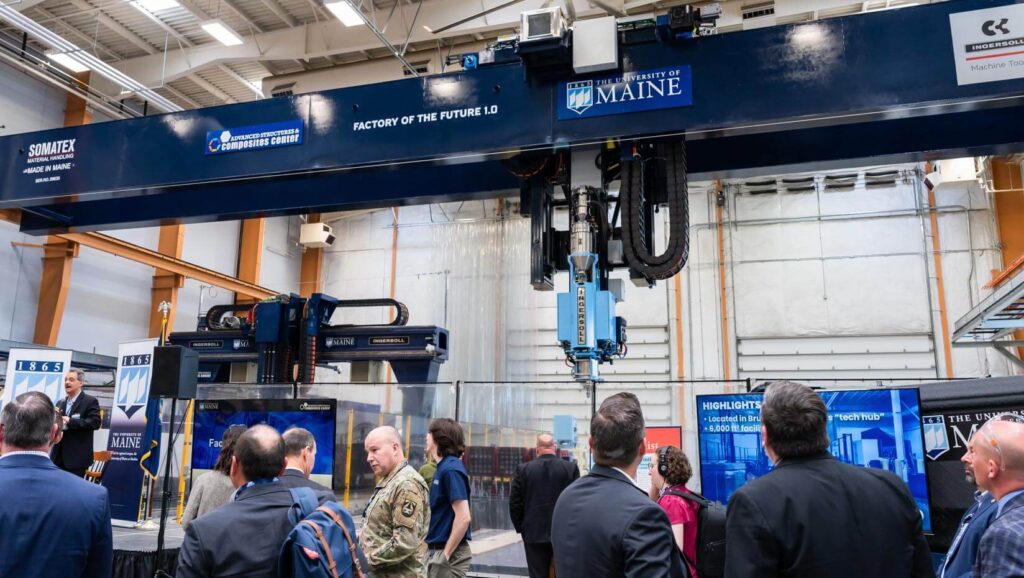The US Government is investing millions into developing supersized 3D printers to build the next generation of infrastructure—for national security and use in affordable housing, bridge construction, ocean and wind technology, and maritime vessel fabrication.
These printers now use “wood dust”—sourced from the US’s most abundant forests—to manufacture greener and more cost-effective building materials.
That is according to the University of Maine, which last month revealed the Factory of the Future 1.0 (FoF 1.0) at the Advanced Structures and Composites Center (ASCC) – a collaboration between the university and the US Departments of Defense and Energy, before members of Congress, Miltary and University faculty.
“UMaine and the Advanced Structures and Composites Center possess the innovation, capacity, and workforce to support the future needs of the Department of Defense in advanced manufacturing,” according to US Senator Susan Collins, and comes after the US Army vowed to use Advanced Cross-Laminated Timbers in future military installations.
The new printer—which smashes the Guinness World Record for the largest 3D printer ever assembled—is four times larger than MasterPrint, also built by the ASCC. FoF 1.0 can print objects 96 feet long by 32 feet wide by 18 feet high, up to 500 pounds of products per hour, “offering new opportunities for eco-friendly and cost-effective manufacturing.”
It switches between various processes, including large-scale additive manufacturing, subtractive manufacturing, continuous tape layup, and robotic arm operations, using woody biomass as a green fuel.
Importantly, it is capitalising on more than 1 million tonnes of waste produced by Maine’s sawmills, which is instrumental in driving the BioHome3D initiative, a new ASCC-led project building 3D-printed houses made entirely with bio-based materials.
According to MaineHousing Development Director Mark Wisendanger, one of the partners in BioHome3D, “Maine needs an estimated 80,000 additional homes by 2030, many specifically for households with incomes at or below the area median income.”

“This new technology allows UMaine-ASCC to scale up its research and production of its innovative biobased 3D-printed home technology,” which, Mr Wisendanger said, “creates another means of producing quality affordable housing while further driving costs down and using abundant wood residuals from Maine’s sawmills.”
For Habib Dagher, the ASCC Executive Director, the new technology “opens up new research frontiers to integrate these collaborative robotics operations at a huge scale with new sensors, high-performance computing and artificial intelligence to create born-certified systems that meet high-quality standards.”
Over the past 18 months, Senator Collins, the Vice Chair of the Senate Committee on Defense, has secured more than US $93 million in Congress support for FoF 1.0 and other initiatives at the ASCC.
“We are grateful for Senator Collins’ support,” Professor Dagher said, adding support from Maine’s congressional delegation was key to the project’s success, along with “collaborations with the Department of Defense, Department of Energy, Oak Ridge National Labs, Maine Housing and our industry partners here in Maine and beyond.”

According to Heidi Shyu, the Defence of Defence’s undersecretary for research and engineering, “the department has been advancing composites and manufacturing technologies with the University of Maine’s ASCC for nearly two decades,” with the latest innovations “instrumental to the security and economic vitality of the US, its allies and partners worldwide.”
Wood Central understands that FoF 1.0 will also be used in building lightweight, rapidly deployable structures for combat and vessel technologies used by the US Navy.
The opening of FoF 1.0 comes just months ahead of the launch of a new 47,000-square-foot research lab, the Green Engineering and Materials (GEM) Factory of the Future. Scheduled for an August groundbreaking, the facility will enhance manufacturing innovation across multiple sectors.
According to a statement from the ASCC, “Its primary aim is to facilitate and scale up more sustainable manufacturing practices by introducing next-generation solutions and biomaterials, addressing challenges such as a diminishing workforce and strained supply chains with local solutions.”
- To learn more about how the US Government wants to use timber-based construction to drive the future of public building construction, click on Wood Central’s special feature.







